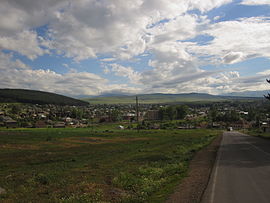Tsalka
Tsalka
წალკა | |
|---|---|
 | |
| Coordinates: 41°35′0″N 44°05′0″E / 41.58333°N 44.08333°E | |
| Country | |
| Mkhare | Kvemo Kartli |
| District | Tsalka |
| Population (2024)[1] | |
| • Total | 3,708 |
| Time zone | UTC+4 (Georgian Time) |
| • Summer (DST) | UTC+5 |
| Climate | Dfb |
 | |
Tsalka (Georgian: წალკა, romanized: ts'alk'a [tsʼaɫkʼa], Greek: Τσάλκα, Armenian: Թռեղք, romanized: T’ṙeġk’ or Ծալկա, Azerbaijani: Barmaqsız) is a town and municipality center in southern Georgia's Kvemo Kartli region.
Population
[edit]
The district had a population of 2,326. According to the 2014 census, 47% of its population is Georgian, 38% Armenian, 7% Caucasus Greeks, and 7% Azerbaijanis. Up until the 1990s, Russian served as the language of inter-ethnic communication and was the language of education in most of the schools in the Tsalka district. It was the only area in the USSR where the Greek language was taught in schools. The population in Tsalka district before 1990 was 55,000 people, and more than 90% Greeks (about 50,000). Before 1990, it was the only city in the USSR with such a high Greek population. There were 49 villages in the district, and 44 were Greek villages. In the past, Greeks used to be the majority of Tsalka, but now their numbers have considerably decreased due to emigration to Greece. Several thousand ethnic Georgians who had suffered from landslides in Svaneti and Adjara were settled in Tsalka in 1997–2006.[2] The settlement of these newcomers sometimes led to ethnic tensions with Tsalka's Greek and Armenian population. According to the 2014 Georgian census, there were only 2,113 Greeks in all of Kvemo Kartli, indicating a further massive drop in numbers of Tsalkan Greeks.
There are important historical monuments in Tsalka: Kldekari Fortress (ninth century) and the church of St. George in Dashbashi (tenth-eleventh centuries). Dashbashi Canyon and its new bridge are also interesting tourist attractions.[3][4]
Climate
[edit]| Climate data for Tsalka (1991–2020) | |||||||||||||
|---|---|---|---|---|---|---|---|---|---|---|---|---|---|
| Month | Jan | Feb | Mar | Apr | May | Jun | Jul | Aug | Sep | Oct | Nov | Dec | Year |
| Record high °C (°F) | 13.5 (56.3) |
16.1 (61.0) |
23.0 (73.4) |
25.9 (78.6) |
26.7 (80.1) |
29.4 (84.9) |
33.6 (92.5) |
33.0 (91.4) |
29.7 (85.5) |
27.0 (80.6) |
21.4 (70.5) |
16.8 (62.2) |
33.6 (92.5) |
| Mean daily maximum °C (°F) | 2.2 (36.0) |
3.2 (37.8) |
6.9 (44.4) |
12.0 (53.6) |
16.5 (61.7) |
20.4 (68.7) |
23.1 (73.6) |
23.5 (74.3) |
19.3 (66.7) |
14.6 (58.3) |
8.6 (47.5) |
4.1 (39.4) |
12.9 (55.2) |
| Daily mean °C (°F) | −3.2 (26.2) |
−2.4 (27.7) |
1.5 (34.7) |
6.4 (43.5) |
10.9 (51.6) |
14.6 (58.3) |
17.3 (63.1) |
17.3 (63.1) |
13.4 (56.1) |
8.8 (47.8) |
2.9 (37.2) |
−1.3 (29.7) |
7.2 (45.0) |
| Mean daily minimum °C (°F) | −8.6 (16.5) |
−7.9 (17.8) |
−3.9 (25.0) |
0.7 (33.3) |
5.2 (41.4) |
8.7 (47.7) |
11.4 (52.5) |
11.1 (52.0) |
7.5 (45.5) |
2.9 (37.2) |
−2.8 (27.0) |
−6.7 (19.9) |
1.5 (34.7) |
| Record low °C (°F) | −31.0 (−23.8) |
−33.4 (−28.1) |
−21.6 (−6.9) |
−12.8 (9.0) |
−5.6 (21.9) |
−3.0 (26.6) |
2.0 (35.6) |
3.3 (37.9) |
−3.0 (26.6) |
−10.3 (13.5) |
−20.6 (−5.1) |
−25.6 (−14.1) |
−33.4 (−28.1) |
| Average precipitation mm (inches) | 18.5 (0.73) |
22.9 (0.90) |
37.2 (1.46) |
73.8 (2.91) |
109.0 (4.29) |
115.4 (4.54) |
54.4 (2.14) |
56.4 (2.22) |
47.8 (1.88) |
47.2 (1.86) |
30.6 (1.20) |
22.3 (0.88) |
635.5 (25.02) |
| Average precipitation days (≥ 1.0 mm) | 5.0 | 5.6 | 7.5 | 10.9 | 14.5 | 12.7 | 8.8 | 8.1 | 7.7 | 8.5 | 5.8 | 5.0 | 100.1 |
| Source: NOAA[5] | |||||||||||||
Notable people
[edit]See also
[edit]References
[edit]- ^ "Population by regions". National Statistics Office of Georgia. Retrieved 29 April 2024.
- ^ Georgia’s Armenian and Azeri Minorities, 22 November 2006 (free registration needed to view the full report) Archived September 15, 2007, at the Wayback Machine
- ^ Dashbashi canyon
- ^ "Tsalka Canyons and Kldekari Fortress - Georgian Tour Magazine". Georgian Tour Magazine. 2015-12-21. Retrieved 2016-05-10.
- ^ "Tsalka Climate Normals 1991–2020". World Meteorological Organization Climatological Standard Normals (1991–2020). National Oceanic and Atmospheric Administration. Archived from the original on 4 September 2023. Retrieved 3 September 2023.
- Anjaparidze, Zaal (March 23, 2005). "Georgia's Greek and Armenian communities decry resettlement plans". Eurasia Daily Monitor.
Further reading
[edit]- (in Armenian) ԾԱԼԿԱՅԻ ՇՐՋԱՆԻ ՀԱՅ ԲՆԱԿՉՈՒԹՅՈՒՆԸ. ԱՆՑՅԱԼԸ, ՆԵՐԿԱՆ ԵՎ ԱՊԱԳԱՆ by Robert Tatoyan






